| |

Traditions, folklore, history and more. If it's Irish, it's here. Or will be!
"People will not look forward to posterity who never look backward to their ancestors."
-Edmund Burke




Quotes
Library: Books, Movies, Music
Prints & Photos
Poetry
Jokes


Shops Ireland
Bunús na Gaeilge
(Basic Irish)
Circle of Prayer
Blessings
Did You Know?
Himself/Herself
Write to Us
Readers Write..
Links/Link to Us
Advertise with us
Awards & Testimonials
Submissions Guide


|
|
|
Culture Corner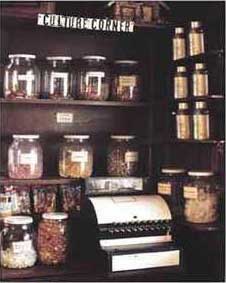
Page 1
Many subscribers and readers have written to ask if they can see our top right corner culture bits. So, we saved them and we're proud to show you a selection of them here.
The 'Harp' Flag
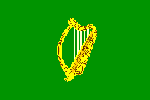 This was the unofficial national flag of Ireland from 1798 until the early years of the 20th century. Since the 16th century, the gold harp had been on a blue field, but the United Irishmen changed the colour to green. This was the unofficial national flag of Ireland from 1798 until the early years of the 20th century. Since the 16th century, the gold harp had been on a blue field, but the United Irishmen changed the colour to green.
The Green Flag was widely carried during the rebellion of 1798 - often with the motto of the United Irishmen, 'Éire go Brágh' - Ireland Forever - included below the harp.
The banner quickly won popular acceptance and it was used by the followers of Daniel O'Connell, by most of the Fenians, and by the supporters of Home Rule from the time of Parnell until the collapse of the Irish Parliamentary Party in 1918.
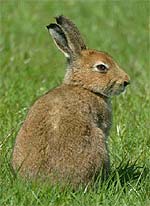 The Irish hare The Irish hare
The Irish hare is unique to the island of Ireland and is arguably the country's oldest surviving mammal. It has been present on the island since before the last ice age, which ended around 10,000 years ago.
Revered and celebrated in Celtic lore for centuries, The lunar hare is seen as carrying an egg, symbolically heralding the new cycle of life that comes with the spring. For ancient communities that had struggled to survive the winter with limited food reserves, eggs were often the first of nature’s bounty to save them from starvation. No wonder then that the hare was revered as a symbol of life and endowed with magical powers.
Irish hares only have about 2 babies in every litter. Unlike rabbits, hares are born fully furred and with their eyes open. Unfortunately, The numbers of these noble animals have declined dramatically in the last three decades. People who live in rural areas report that hare numbers are only a fraction of what they once were. With little protection in law, this unique species remains endangered and is now locally extinct in some areas.
Copy Sources & Photo Credit:
Irish hare
Ask About ireland
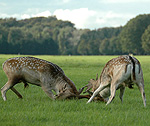 The Phoenix Park, Co. Dublin The Phoenix Park, Co. Dublin
Five times the size of Hyde Park in London and twice as big as Central Park in NYC, Páirc an Fhionn-Uisce is the largest urban enclosed park in Europe, with a circumference of seven miles and a total area 1,760 acres. Located west of the city centre, it features ornamental gardens, nature trails, and broad expanses of grassland separated by avenues of trees. A herd of fallow deer have roamed the forested areas since the 17th century. Main attractions within the park include Aras an Uachtaráin - the residence of the Irish president and Dublin Zoo. The name is a corruption of the Irish fionn uisce meaning "clear water".
Photo Credit: Dublin i.e.
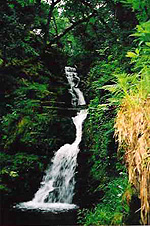 O’Sullivan’s Cascade, Killarney O’Sullivan’s Cascade, Killarney
According to legend the waterfall once ran with whiskey. The Chieftain of the Fianna, Fionn MacCumhal, resided above the Cascade on Tomies Mountain. It was here that he kept his personal supply of the finest uisgebeatha. O'Sullivan of Tomies was lucky enough to share this delightful drop, being the only man bold enough to stand up to Fionn. Sadly, when the Sassenagh invaded Ireland, O'Sullivan's Cascade changed into water.
Photo credit: Synergise
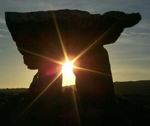 Poulnabrone Poulnabrone
Perhaps the most iconic of Irish dolmens, it is one of over 70 megalithic tombs located in The Burren in Co. Clare. With a name that literally means 'The hole of the sorrows’, Poulnabrone features a capstone which sits on two 6ft high portal stones to create a chamber. It was excavated in 1968 and found to contain the remains of "between 16 and 22 adults and 6 juveniles, including a newborn baby". Radiocarbon dating suggests that the burials took place between 3800 and 3200 BC
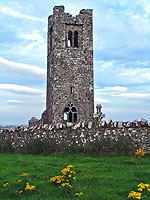 The Hill of Slane The Hill of Slane
It had long been known as sacred ground when St. Patrick visited the hill on the eve of Easter in 433 A.D. He lit a Paschal or Easter fire which could be seen from the nearby hill of Tara, the royal seat of power. There, a fire also burned to celebrate the pagan feast of Beltane. Since it was against the law to light any fire in the area while this was taking place, Laoghaire, the king at that time, was furious and rode off with his retinue to arrest the mystery rebel. Miraculously - some say through an earthquake, others by holding up a shamrock- St. Patrick convinced the king of his belief in Christianity and the power of the Holy Trinity. It was a power that St. Patrick thought would be useful to the king who only wished that his soldiers could be as brave as St. patrick and his followers. He took the group prisoner and marched them back to the Hill of Tara. The next day, they were spared and were allowed to preach Christianity to the pagan army. Today, at the top of the hill are the ruins of a Franciscan Monastery built in 1512.
Photo Credit: Katie Simpson
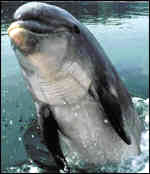 Fungie, the Dolphin of Dingle Bay Fungie, the Dolphin of Dingle Bay
The dolphin is one of Ireland’s most fascinating mammals and Fungie is the most famous. He is a fully- grown bottlenose who is 13 feet (4 meteres) long and weighs about 500 lbs or around one-quarter tonne.
Fungie was first noticed in 1984 when Paddy Ferriter, the Dingle Harbour lighthouse keeper, began watching a lone wild dolphin escort the town's fishing boats to and from port.
Later that year, it became officially recorded that Fungie was a permanent resident of the entrance channel to Dingle and the self-appointed “pilot” of the fleet.
Over the years Fungie has developed from a timid but inquisitive observer of the human visitors into a playful, though mischievous, companion. From observation of marks on his body, it seems that he does 'interact' with other whales, dolphins or porpoises, proving perhaps he is neither hermit nor outcast from his own kind, but rather that he is simply content to spend most of his time in and around Dingle Bay.
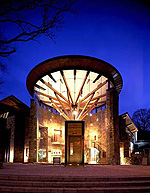 St. Patrick's Centre St. Patrick's Centre
The St. Patrick Centre is the only permanent exhibition in the world dedicated to Ireland's Patron Saint and is one of the top tourist destinations in Ireland.
Located next to Down Cathedral and Patrick's Grave, the centre provides a cutting edge interactive experience. Bold graphics, sculptures, video and audio technologies bring St. Patrick's story to life, drawing from the available evidence of his own writings and literary artefacts. The centre is also a central hub on the St. Patrick's Trail through Counties Armagh and Down.
Click here for St. Patrick's Centre.
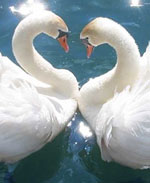 Irish God and Goddess of love Irish God and Goddess of love
Oengus is the Irish God of love, beauty and youth. According to the old folklore, his kisses became birds. It is also said that he dreamed of a beautiful maiden, named Caer, for whom he searched all over Ireland. Eventually, he found her chained to 150 other maidens, destined to become swans at the time of Samhain. Legend has it that Oengus transformed himself into a swan and was united with his love.
Aine of Knockaine is the Irish Goddess of love. She is also known as the Fairy Queen of Munster and as a goddess of fertility beause she has control and command over crops and animals, especially cattle. Another name by which she is known is Aillen. To learn more about Irish mythology, please click Irish Myths & Legends.
Photo Credit: Wikipedia
Irish Brooches
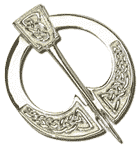 From the third century on, brooches played an important role in the attire of the Irish. The Tara Brooch is the most famous - and many of us think it was from Tara, hence the name. Although it was discovered in County Meath, it was found in Bettystown. A jeweler who studied the brooch is credited with the misnomer. From the third century on, brooches played an important role in the attire of the Irish. The Tara Brooch is the most famous - and many of us think it was from Tara, hence the name. Although it was discovered in County Meath, it was found in Bettystown. A jeweler who studied the brooch is credited with the misnomer.
Brooches served much more than a decorative purpose. They were used by both men and women to fasten their cloaks and two distinctive styles emerged: the pennanular featuring a gapped ring (shown) and the pseudo-pennanular, which had a closed ring.
Usually made of bronze in earlier times, and then often of silver and gold after the Vikings invaded, Irish brooches were famous for their intricately detailed engraving, enamel inlays and exquisite craftsmanship.
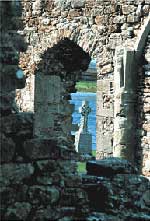 Clonmacnoise Clonmacnoise
Founded in 545 AD by St Ciaran, Clonmacnoise monastery became between the 7th and 12th centuries a religious, literature and arts center for monks all over Europe. They came to study and pray in the “Island of saints and scholars” when the rest of Europe was still in the Dark Ages. Clonmacnoise was totally devastated by fire as well as successive raids but the site retains its stunning features. The view captured in this image has remained relatively unchanged for 1500 years. Clonmacnoise lay in decay until the Office of Public Works began the arduous task of turning this sacred place into one of Ireland's most famous visitors' centres. Interestingly - and we have yet to find out why - for centuries, courting couples have stood on each side of the arch whispering their words of love to each other.
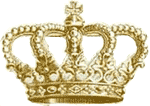 Instructions of King Cormac, King of Cashel Instructions of King Cormac, King of Cashel
(Kids Ireland)
Be not too wise, nor too foolish
Be not too conceited, nor diffident
Be not too haughty, nor too humble
Be not too talkative, nor too silent
Be not too hard, nor too feeble.
If you be too wise, men will expect too much of you
If you be too foolish, you will be deceived
If you be conceited, you will be thought difficult
If you be too humble, you will be without honour
If you be too talkative, you will not be heeded
If you be silent, you will not be regarded
If you be too hard, you will be broken
If you be too feeble, you will be crushed.
 Dunguaire Castle Dunguaire Castle
Situated on Aughnish Bay, an inlet of Galway Bay, the castle was built by the O'Heynes in 1520. It was near this site that their ancestor, King Guaire Aidhne, the Hospitable, ruled Connaught in the 7th century.
In the 17th century, the castle passed to the Martyns of Tullira.
Edward Martyn, who, along with W.B. Yeats and Lady Augusta Gregory of Coole Park, founded the Irish Literary Renaissance Society and the Abbey Theatre, sold the castle in1912 to their friend and fellow writer, Oliver St. John Gogarty.
The castle was acquired in 1954 by Christobel Lady Ampthill who completed the restoration work started by Gogarty.
Medieval Banquets are held in the castle each night and celebrate the richness of its literary and musical past.
For a print of this photograph, click Dunguaire
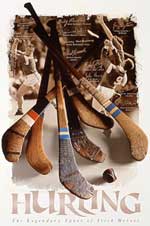 Hurling Hurling
(Kids Ireland)
This game, which is often described as "the clash of the ash" is the oldest team sport in Ireland. It's played by two teams of 15 players to a side. The girl's version of the game is called Camogie and there are 12 players to a side. One player acts as a goalkeeper while the others try to hit a small leather ball called a sliotar past the goalkeeper. The stick they use is made from the wood of the ash tree. It's shaped a bit like a hockey stick and is called a hurley or camán.
Even in ancient times, there were very strict rules about how the game should be played. Throwing the ball is not allowed; it must be lifted off the ground with the hurley or foot; and to strike an opponent was punished with severe penalties. In today's game, the player is sent off the field.
To buy this Poster click Hurling.
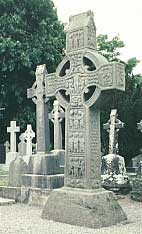 The Celtic High Cross The Celtic High Cross
As symbolic of Ireland as the harp and the shamrock, high crosses first appeared as early as the 7th century. Originally, the designs were abstract, but gradually, they began to feature more spiritually-based themes. Most of these ancient crosses were made of various types of sandstone, which is somewhat easy to carve. Today, of the more than 200 that remain, many are in an eroded state and the details are barely discernible. However, some excellent examples can be found, if you know where to look. Several can be seen at the Monastery of Monasterboice in Co. Louth, including the exquisitely sculptured Muiredach's Cross shown here.
Image by kind permission of Mary Ann Sullivan
 The Round Towers The Round Towers
The Round Towers of Ireland are remarkable among the world's ancient monuments; one author has called them 'Elegant, free-standing pencils of stone.' Today, 65 survive in part or whole. Hand-crafted in native stone and cemented with a sand, lime, horsehair and oxblood mortar - a technique imported from Roman Britain - it's said by many historians that they were built by monastic communities to thwart Viking invaders. And yet, there's reason to believe that the towers were built long before Christianity came to Ireland. Whatever their origins, monasteries did indeed flourish where the round towers existed. And why not. These imposing edifices provided a watch tower, a keep and a refuge.
Image: By kind permission of Stephen Cassidy, The Cassidy Clan.
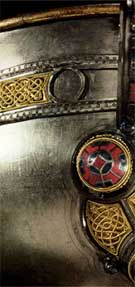 The Ardagh Chalice The Ardagh Chalice
One of the finest specimens of Celtic art ever found, the cup combines classic beauty with exquisite Celtic ornamentation. It is composed of gold, silver, bronze, brass, copper, and lead and comprises 354 pieces, including 20 rivets. A band running round the outside of the bowl is engraved with the names of the twelve Apostles. Discovered near Ardagh in 1868, almost nothing is known of its history. 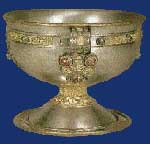 It is believed to date from the 8th century and might be one of the cups stolen from Clonmacnois, in the year 1125. It is believed to date from the 8th century and might be one of the cups stolen from Clonmacnois, in the year 1125.
The cup is on display at the National Museum of Ireland in Dublin and is part of the "National Treasures" collection which includes the Tara Brooch and the Cross of Cong.
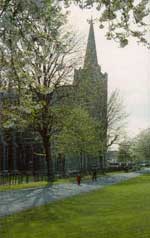 St Patrick's Cathedral St Patrick's Cathedral
The National Cathedral and Collegiate Church of St. Patrick is the full official name and, according to tradition, St Patrick baptised several converts at a well in what is now a park adjacent to the cathedral. To commemorate this event, a small wooden church was built. In 1901, the well was rediscovered and an ancient granite stone, marked with a Celtic cross which covered the well, was moved into the cathedral. The parish church on this site was one of four Celtic churches in Dublin and was known as St Patrick's in Insula - on the island - as it was built on an island between two branches of the River Poddle which still flows under the cathedral.
Image: StPatrick's Cathedral.ie
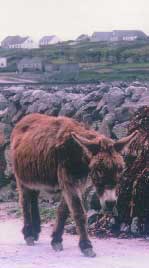
The Donkey in Ireland
(Kids Ireland)
The donkey was once a very important part of family life in Ireland. Eggs and butter were brought to market every week by a donkey harnessed to a small cart, usually driven by the farmer's wife. Donkeys were also used to move seaweed from the beaches to use in gardens and fields to help vegetables grow; and the donkey also carried peat from the bog back to the house where it was used as fuel for the fire. You can still find working donkeys, mostly in the West of Ireland, but not like in the old days. It's said that donkeys make the perfect companion because they are smart, patient and their gentle nature makes them very easy for both grownups and children to handle.
Image: Laura Jean Zito
 Thoor Ballylee - Yeat's Tower Thoor Ballylee - Yeat's Tower
Located by the River Cloon near Gort in Co. Galway, Thoor Ballylee was originally owned by the de Burgo family. W. B. Yeats was so enchanted with the 16th-century tower house that he purchased the property in 1916 and restored it. After he moved out in 1929, it fell into disuse. For the centenary of the poet's birth in 1965, Yeat's Tower was restored as a museum. To remind visitors that it was once the poet's home, there is a tablet on the wall:
"I, the poet William Yeats,
With old mill boards and sea-green slates,
And smithy work from the Gort forge,
Restored this tower for my wife George;
And may these characters remain
When all is ruin once again."
Photo Credit: Panoramio/©Albert Bordons
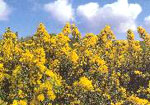 Irish Furze Irish Furze
Called when in the north and gorse in the east, furze was once a symbol of wealth and fertility of land as is emphasized by the saying: "gold under furze, silver under rushes and famine under heather."
As indigenous to the early summer landscape as rhododendrons, it is despised by farmers because of its invasive properties; but in the past, it had many good uses.
It ignites quickly, so it was used for starting the fire: it was also used for cleaning the chimney, tilling the soil, dyeing wool and fabric, and as a flavouring for whiskey (which may have improved its rating with the farmers!). It had medicinal powers and its magical powers were undisputed in preventing the good people from stealing the butter on May day. And, at mid-summer, blazing branches were carried round the herd to bring good health to the cows for the coming year.
Resources: Doon Mayo
and Farmers Journal
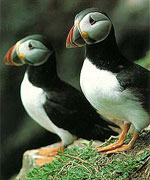 Birds that like to visit Ireland Birds that like to visit Ireland
(Kids Ireland)
Did you know that thousands of birds from other countries migrate to Ireland throughout the year? The arrival of these feathered tourists can be observed in April and May all along the south coast. In summer The cliffs of the west of Ireland are the ideal place for large sea bird colonies such as puffins and gannets. And in autumn, we have many rare American waders - mainly sandpipers and plovers - who arrive here when blown across the Atlantic. In winter, lakes, estuaries and wetlands are a haven for hundreds of thousands of waterfowl from the Arctic and Northern Europe. From Greenland, Iceland and Canada come waders such as knot, golden plover and black-tailed godwit, flocks of brent, barnacle and white-fronted geese, as well as thousands of whooper swans.
Puffin picture and edited copy: Gorp Europe
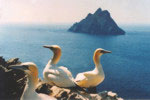 The Islands The Islands
There are hundreds of islands around the Irish coast. Achill is the biggest, the Arans the most romantic; Skellig Michael the most dramatic and Tory the most menacing - at least in legend. The Blaskets offer the most fertile ground for literature and Clare island is the most meticulously studied.  But, whichever island you may visit, you can be sure each of them has its own superlative. For example, Little Skellig off St. Finian's Bay in Co. Kerry, is known for its gigantic colony of white seabirds called gannets. But, whichever island you may visit, you can be sure each of them has its own superlative. For example, Little Skellig off St. Finian's Bay in Co. Kerry, is known for its gigantic colony of white seabirds called gannets.
Content edited and adapted from the book "Ireland - Atmosphere & Impressions" by Dr. Christopher Moriarty.
Photo Credits:
Gannets from Skellig Experience
Skellig Archway from Travel Publishing
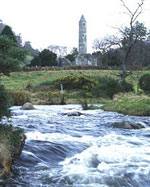 Glendalough - the glen of the two lakes Glendalough - the glen of the two lakes
The location is spellbinding. It encompasses two clear water lakes situated beneath the sheer cliffs of a deep valley which was carved out by glaciers during the Ice Age. The perfect spot for a serene monastic settlement.
Today, Glendalough is one of the most important sites of monastic ruins in Ireland. Fourteen centuries have passed since the death of its founder, St. Kevin, when the valley was part of Ireland's Golden Age.
The buildings which survive probably date from between the 8th and 12th centuries. The famous Round Tower is in near perfect condition even though it is almost 1,000 years old. To learn more, please click St.Kevin.
Photo Credit: Irish Corner.
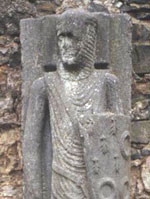 Cantwell Fada Cantwell Fada
Kilfane Church, Co. Kilkenny
On the North Wall, inside the ruins of the 14th century Kilfane church is an effigy of a Norman knight carved in high relief from a single slab of limestone. Except for the face, the body is completely covered in a suit of chain mail.
Known as the Cantwell Fada (long man), its larger-than-life size makes it the tallest such effigy in Ireland and Britain. The legs are crossed, the right over the left, and this is thought to signify that the knight took part in the crusades. In the left hand is carried a large shield bearing the arms of the Cantwell family.
The Cantwells were Lords of Kilfane and adjoining areas from shortly after the arrival of the Normans.
Image: Eircom Cantwell Fada
 The Irish Wolf The Irish Wolf
(Kids Ireland)
Was the last Irish wolf killed in 1786 in Co. Carlow? Or was it in 1773 in Co. Wexford? No-one seems to know for sure. What we do know is that not so long ago, there were many wolves in Ireland.
However, with the coming of the English settlers, there was a campaign to eliminate the wolf from the Irish countryside. This was because it was thought the wolf would eat the farm animals.
Wooded areas were cleared, and farmland was created, so that wolf habitats were wiped out. Bounties were also offered to professional hunters
By the early 1700s, wolves had retreated to a small number of places in Ireland as far away from people as possible. When the last wolf was killed, it meant the loss of the only major carnivore to survive into relatively recent Irish history.
Image: Art Print by Daniel J. Cox. This print is for sale at All Posters.
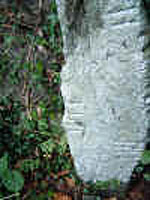 Ogham Ogham
The Ogham alphabet is thought to be named after the Irish god Ogma. The word is pronounced OH-am or OH-yam; the first pronunciation is most common, but a native Irish speaker has claimed that the second is most "proper." While all surviving traces of Ogham are inscriptions on stone, it was most likely more often inscribed on sticks, stakes and trees. Inscriptions generally take the form of a person's name and the name of a place and were probably used to mark boundaries. Each letter is named after a tree or other plant and has a number of other associations. Letters are linked together by a solid line, which represents the trunk of a tree, while the letters themselves represent branches or twigs. To learn more, click Every Ogham Thing on the Web
Photo Credit: Shee-Eire
 From Bog Land to Turf Fire From Bog Land to Turf Fire
Ireland contains more bog land, relatively speaking, than any country in Europe, except Finland. For people in rural areas, turf cut from the bog is still a natural source of heat. Turf cutting begins in spring and then the turf is spread and rickled . Rickled means to pile the turf up in small mounds. By summer, the turf is dry and it's time to bring it home. Everything has to be prepared before the winter comes, or even earlier, because the rain would wet the turf too much. It has to be dry and in the shed before Autumn. Then and only then, can an irish country family look foreword to the cozy warmth of "a turf fire in the cabin."
Resources: The Atlas of the Irish Rural Landscape
Image: Spirited ireland
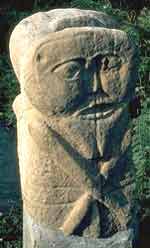 The idols of Boa Island The idols of Boa Island
Boa is at the lower end of Lough Erne in Co. Fermanagh. Here, in the ancient Caldragh cemetery are two pre-Christian stone figures - the Janus statue and a smaller statue, the Lusty Man. Shown is the more famous of the two - a double-sided figure of two beings carved back-to-back. Interestingly, this type of figure is often referred to when the calendar year has just turned and we are glancing back even as we move forward. Also, the month of January is named after Janus, the Roman god of doors and gates. Often flowers and coins are left at the base of both statues - perhaps for good luck in the new year? Speculation as to what the idols represent continues.
Photo Credit: Bucknell University
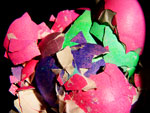 Making a May Bush for Beltane Making a May Bush for Beltane
(Kids Ireland)
Beltane is on May 1st and it’s a very old celebration to mark the beginning of the summer season. Long ago, children saved the colored shells from their hard-boiled Easter eggs and added them to the decorations for the May Bush which was a small shrub chosen for the honour. It was cut down and placed in front of the house in the days or weeks before Beltane. The children would then decorate it with flowers, ribbons, and Easter egg shells. Candles or rush lights* were attached to the bush and were lighted at dusk. In the cities, the May Bush was made by neighbours and sometimes there were attempts to steal it by folks from other neighbourhoods. It was said that you’d be taking the year's luck from the rightful owners. So, the May Bushes were fiercely guarded until the evening of May Day, when the bush would be cast into the Beltane Bonfire.
*To find out about rush lights, please click Wikipedia.
Photo Credit: RushMi.
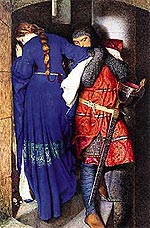 Ireland's Favourite Painting Ireland's Favourite Painting
In a campaign conducted by RTE to find out what painting in the National Gallery was Ireland's favourite, the public chose Frederic William Burton's "Hellelil and Hildebrand, The Meeting on the Turret Stairs." The richly-coloured piece captures the poignant final embrace of the ill-fated lovers. The story goes that the princess Hellelil's father regarded the young soldier Hildebrand as an unsuitable match for his daughter and ordered his sons to kill him. Painted in 1864, it was presented to the National Gallery of Ireland in 1900 by Margaret Stokes, a sister of Whitley Stokes, whose translation of the Danish Ballad inspired Burton. Despite the tragedy portrayed, it is still viewed as one of the most romantic paintings in Ireland. Adding to its mystique is that it is only available to view for three hours each week, due to its medium and sensitivity to light.
Image Credit: National Gallery of Ireland
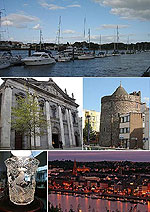 Ireland's oldest city Ireland's oldest city
Waterford
Situated in south eastern Ireland on the river Suir - pronounced Shure - Waterford was founded by the Vikings in 914. It was taken over by the Anglo-Norman invaders of the 12th century and was one of the most important Old English centres in medieval Ireland. Today, Waterford is world famous for its intricately cut crystal which was made in the city from 1783 until early 2009. Waterford is also known for being the home of Ryanair which began operations in the city with a 14-seat turboprop aircraft flying between Waterford and Gatwick Airport. Other claims to fame include being the first place where the the tri-colour flag of the Irish Republic was flown; it's also where the the modern bacon curing process was invented and it's where Ships Biscuits were first manufactured by Jacobs - they're better known nowadays as cream crackers!
Source: Wikipedia
Image: Collage: Coleman Huge2
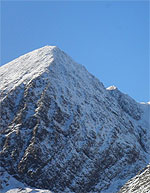 Ireland's highest mountain Ireland's highest mountain
Carrauntoohil is the highest peak on the island of Ireland. Located in Co Kerry, it is 1,038 metres (3,406 ft)[1] high and is the central peak of the Macgillycuddy's Reeks range. The ridge northward leads to Ireland's second-highest peak, Beenkeragh (1,010 m), while the ridge westward leads to the third-highest peak, Caher (1,001 m). Carrauntoohil overlooks three bowl-shaped valleys, each with its own lakes. To the east is Hag's Glen or Coomcallee (Com Caillí, "hollow of the Cailleach"), to the west is Coomloughra (Com Luachra, "hollow of the rushes") and to the south is Curragh More (Currach Mór, "great marsh").
Source: Wikipedia
Photo Credit: Howling Mist
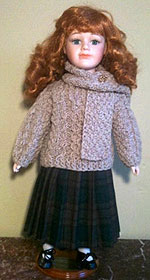 Crolly Dolls Crolly Dolls
(Kids Ireland)
Have you ever heard of a Crolly Doll? They were once as popular in Ireland as Barbies are today. They were made in a factory in Co Donegal, which opened in 1939. The earliest dolls were handmade with a soft body and porcelain face. Their clothes were also handmade with Irish materials such as Donegal tweed as well as hand-knit Aran sweaters like the doll shown. Her name is Clodagh.
Because the dolls were so well made, they quickly became one of the most wanted gifts at Christmas. In fact, people used to line up for hours to buy one and demand was so high that toy shops allowed just one or two per customer.
Sources:
Wikipedia
Ask about Ireland
Free Pages Geneology
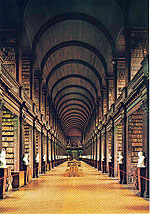 The Long Room, Trinity College Library, Dublin The Long Room, Trinity College Library, Dublin
One of Dublin's most popular visitor attractions, it houses 200,000 of the Library's oldest books, including the Book of Kells. Originally built between 1712 and 1732, its roof was raised to accommodate an upper gallery in 1860. The Long Room also holds one of the last remaining copies of the 1916 Proclamation of the Irish Republic as well as the Brian Boru harp- the oldest of its kind in Ireland dating back to the 15th century. The room is lined with marble busts - a collection that was formed when 14 busts from the famous sculptor Pieter Scheemakers were acquired by the college.
Copy Source: Atlas Oscura
Photo Credit:TimeStream/Scanned fro a postcard
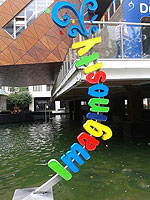 Imaginosity Dublin Children’s Museum Imaginosity Dublin Children’s Museum
(Kids Ireland)
Imaginosity is the only dedicated children's museum in the South of Ireland. Designed for children up to nine years of age,the museum encourages and enables them to be whomever and whatever they want to be. Visitors can become a mechanic in The Garage, examine an x-ray in Dr Apple-a-Day’s Surgery, choose the evening meal in the Village Market and cook it up at the Dublin Diner. Sing, dance and dress-up in costumes in The Theatre or present the News at the TV Station or become an engineer in the construction zone and much,much more.
Copy Source: Discover Ireland
Photo Credit: Trip Advisor Reviewer
More Culture Corner - Page 2
|
|
Sat, Sep 28, 2024
 The Galway Hooker The Galway Hooker
This unique vessel, with its distinctive curved lines and bright red sails, originated in the village of Claddagh. During the 19th century, hookers supported a significant fishing industry and also carried goods, livestock and fuel. Seán Rainey is remembered for building the last of the original boats, the Truelight, for Martin Oliver who was to become the last king of the Claddagh; as king, he was entitled to white sails on his boat. Since the mid seventies, many of the old sailing craft which were on the verge of extinction have been lovingly restored and new ones have been built. During the summer months they can be seen at festivals such a Cruinniú na mBád - the Gathering of the Boats - in Kinvara.
Click for More Culture Corner.
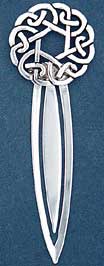
Celtic Bookmark
Elegant bookmark is made of silver over pewter. It measures 3" x 1". When in use, the pretty Celtic design sticks out of your book. Or choose Trinity Knot or Celtic Heart.
Click for Celtic Book mark.
|
|
|




 The Galway Hooker
The Galway Hooker